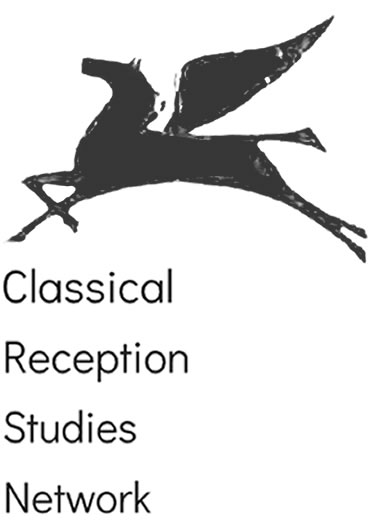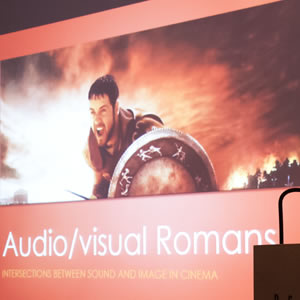— Report by Maria Wyke (UCL)
Cinema from its beginnings offered a radically new way of experiencing ancient Rome. Film brought ancient Rome to life, and gave it colour, movement and sound. Quite unlike a visit to an excavation or a museum, a trip to the cinema offered a communal immersion into the Roman past that was not so much about accruing knowledge as experiencing feelings.
Here I comment on a number of activities in which I was involved in May 2018 in the city of Rome that were designed to explore in particular, and from multiple perspectives, the complex relationship of sound to image in films about Roman antiquity. How does film music provide a profoundly emotional coding for our viewing of Roman history? What conventions lie behind the way Romans talk on screen? How has Hollywood tried to dress up contemporary English in order for it to sound authentically Latinate?
These events formed part of the Audio / Visual Romans project established by myself and Monika Woźniak (Sapienza, University of Rome) and generously funded by University College London through its Rome Regional Engagement Fund.
 On 8 May 2018, we held a roundtable discussion at the British School at Rome on the intersections between sound and image in films about Neronian Rome, specifically the various film adaptations of the Polish novel Quo vadis? released in 1913, 1924 and 1951.
On 8 May 2018, we held a roundtable discussion at the British School at Rome on the intersections between sound and image in films about Neronian Rome, specifically the various film adaptations of the Polish novel Quo vadis? released in 1913, 1924 and 1951.
Speakers and audience explored how the music that accompanies these films provides an aural encoding of Nero’s Rome. It has to be relevant to the time of the films’ production yet evocative of the classical past. It has to be built on earlier musical traditions or devised from scratch. Music is also expected to draw spectators into cinema’s Roman world and invite them to be moved by it.
In sound film, dialogue too must be both comprehensible to audiences and compatible with the epoch represented on screen. Dialogue stakes a claim to history by anchoring protagonists and events in past time, establishing narrative coherence and revealing the personality of characters. The fictionalised ‘Latin’ of Hollywood historical films often follows invented patterns of communication that signal the classical past in a stilted literary style while also being steeped in the vocabulary and ideology of the present day: the voiceover at the start of the Cold-War Quo vadis? proclaims that in summer 64 AD: ‘No man is sure of his life, the individual is at the mercy of the state, murder replaces justice. Rulers of conquered nations surrender their helpless subjects to bondage.’ While Petronius complains of Nero’s singing: ‘Body of Bacchus, I’ve been listening to that since morning!’.

We also considered how sometimes art house cinema and other types of musical accompaniment breach those conventions in order to construct a less comfortable relationship for spectators with the Roman past (just think – Fellini Satyricon, 1969).
On the same evening, we screened the celebrated silent feature film Quo vadis? (1913, dir. Enrico Guazzoni) – a beautifully restored, coloured version loaned to us by EYE, the Netherlands Film Archive. The screening was accompanied on the piano by Michele Sganga who had composed his own original score to support the dramatic display. Back in 1913, when the film was first exhibited at the Gaumont Palace in Paris, a reviewer expressed amazement at how the orchestra and choir which the Gaumont had engaged brought Neronian Rome to life: ‘Nero sings his verses, his lyre vibrates. Rome is set on fire, the choir sings the hatred of the people… Plaintive and slow, comes the chant of the Christians who go to be tortured’.
Our audience at the BSR commented no less enthusiastically on how much they had learned from the screening about the relationship of visual image to musical score. The performance was an astounding and disturbing success (when the Christians were set alight on screen, Michele stood up to scream). A journalist attending from Rai television interviewed him subsequently about his interest in composing for silent film in this way. Here’s the short discussion:
The following day, we moved location to Sapienza and held a practical and collaborative workshop for about twenty students from my institution and Monika’s (with backgrounds variously in Classics, History, English, and Comparative Literature). The task we set them was to audio describe a scene from the Hollywood Quo vadis? And at first they did wonder quite what the intellectual benefits of a task like that would be.
 Audio description is a mode of narration that provides a verbal version of visual media for blind or visually impaired consumers. It was first developed in the 1970s in the United States but now has global reach. You can access AD, for example, on Netflix. AD encompasses the visual aspects of film action: body language, facial expression, props and costumes, movement, even lighting effects. The audio describers have to ensure they do not extend their commentary beyond the scene in question. Studies have found that trained audio describers develop excellent observational skills and enhance their visual literacy.
Audio description is a mode of narration that provides a verbal version of visual media for blind or visually impaired consumers. It was first developed in the 1970s in the United States but now has global reach. You can access AD, for example, on Netflix. AD encompasses the visual aspects of film action: body language, facial expression, props and costumes, movement, even lighting effects. The audio describers have to ensure they do not extend their commentary beyond the scene in question. Studies have found that trained audio describers develop excellent observational skills and enhance their visual literacy.
We mixed our UK and Italian students in groups, each working to produce their own AD for a brief scene of romance between the soldier hero and Christian heroine of Quo vadis? and then shared and commented on the results with the aid of a number of specialists in this technique from Sapienza who had also explained in advance what you might include in AD for films. The students reported back afterwards that the exercise forced them to think carefully about the filmmaking process (the essentials of mise-en-scene, choreography, gesture and expression) that goes towards the creation of a seemingly authentic Roman world.
Plans are already afoot for further such collaborations between UCL and Sapienza on Audio / Visual Romans.

